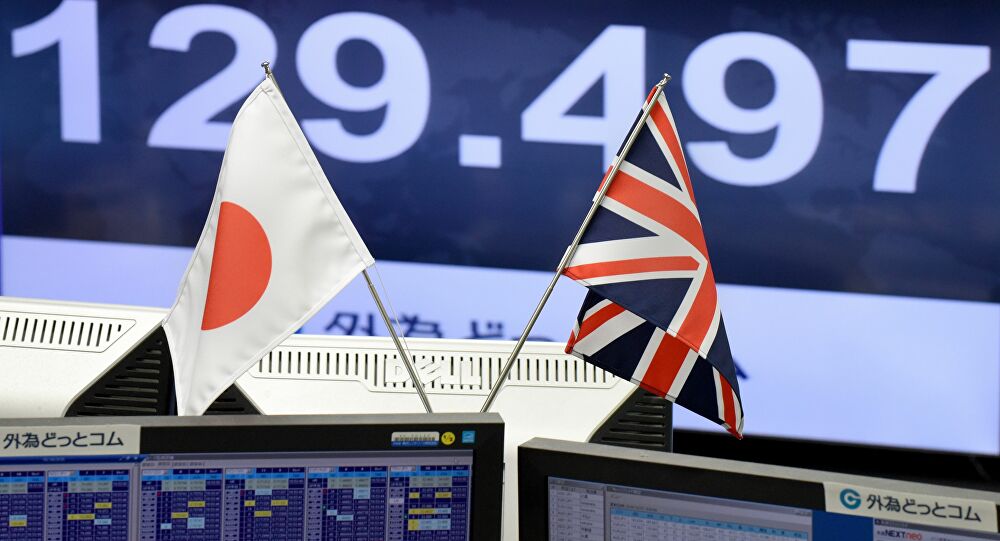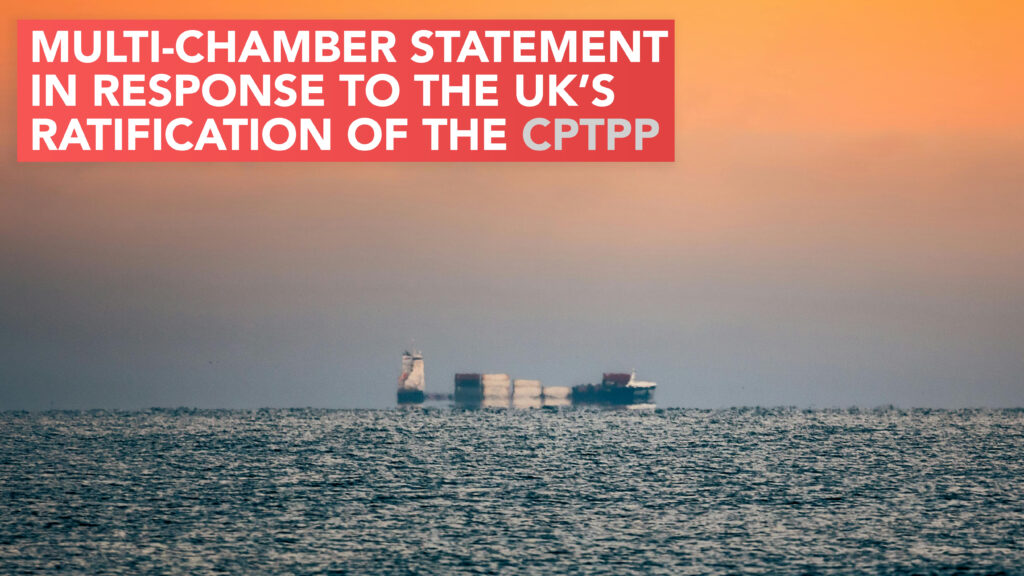Member? Please login
Trade with Japan from 1 January 2021 / CEPA

Written by BCCJ
December 3, 2020
UK Gov / British Embassy Tokyo, UK-Japan Relations
Source: https://www.gov.uk/guidance/summary-of-the-uk-japan-comprehensive-economic-partnership-agreement
How you import from and export to Japan will change from 1 January 2021.
The UK signed a free trade agreement (FTA) with Japan on 23 October 2020. This Comprehensive Economic Partnership Agreement (CEPA) maintains the benefits of the EU-Japan Economic Partnership Agreement (EPA) with enhancements in areas of mutual interest. The EU-Japan EPA remains in force in the UK until 11pm on 31 December 2020.
This guidance provides information on the key terms of trade for UK businesses trading under the CEPA that will be in force from 1 January 2021.
For Japanese businesses trading with the UK, see information on exporting to the UK from Japan.
Find out which provisions each chapter of the CEPA covers.
For the full CEPA text and other key documents, see the UK-Japan Comprehensive Economic Partnership Agreement collection page.
Tariff rates on goods
Commitments on tariffs for the vast majority of products traded between the UK and Japan have been transitioned in CEPA without changes.
In some cases, the tariff rates may be lower than the EU-Japan EPA. In the UK’s tariff schedule, 21 industrial goods tariff lines which have duties eliminated in the UK Global Tariff schedule also have their duties eliminated in the CEPA tariff schedule. Tariffs on two tariff lines covering electrical control units often used in cars are also eliminated at entry into force on 1 January 2021, instead of in 2024 in the EU-Japan EPA.
In Japan’s tariff schedule, nine tariff lines covering certain leathers and hides will become duty free in 2026 rather than in 2028 under the EU-Japan EPA. One tariff line covering industrial ethanol, which became duty free in 2028 under EU-Japan EPA will have duties eliminated as of 1 January 2021.
Online tools
You can use online tools to check product-specific and country-specific information on tariffs and regulations:
- look up tariffs, taxes and rules to trade with the UK
- check duties and customs procedures for exporting goods
These tools are regularly updated to reflect any changes.
Import tariff rate quotas
Access to products covered by tariff rate quotas (TRQs) differ in the CEPA compared to the EU-Japan EPA.
Under the CEPA, the UK will continue to have access to the same preferential tariff rate as in the EU-Japan EPA for 10 TRQs:
- TRQ 1: Wheat products
- TRQ 2: Mixes and doughs and cake mixes
- TRQ 3: Food preparations made primarily of wheat
- TRQ 8: Food preparations of barley
- TRQ 11: Coffee, tea mixes, food preparations and doughs
- TRQ 12: Food preparations
- TRQ 15: Food preparations containing more than 50% of sucrose, and cocoa powder
- TRQ 19: Food Preparations containing cocoa
- TRQ 20: Food Preparations containing cocoa (for the preparation of chocolate)
- TRQ 25: Cheeses
See the high level summary of agri-food market access. This summary also covers arrangements for access to products covered by TRQs in the EU-Japan EPA.
The quota available to Japanese importers for British products will be the entirety of any unutilised EU quota in that year.
Malt
For malt, the UK will continue to have duty-free access to Japan’s market for malt via the existing Global TRQ.
Before Permit (BP) scheme
The new CEPA arrangement uses Japan’s BP scheme.
This scheme temporarily suspends the need to pay tariffs at the border. The importer must provide a guarantee to the customs authority. One way of doing this is via a Banker’s Guarantee. This means that at the point of import, Japanese importers would only need to register the import under the BP scheme.
Japanese importers will be able to register an import under the BP scheme through Japan’s digitalised system for customs procedures. Find detailed information on how the new CEPA arrangement operates.
The Japanese government provides information (in Japanese language only) on the EU-Japan EPA allocations and returns of TRQ quotas throughout the year. They will also publish information on the availability of quota for imports from the UK.
To find out more about the new arrangements, see Annex 2-A of the CEPA.
Rules of origin
Claiming preferential rates for your exports from the UK
The requirements for claiming preference remain largely unchanged. A claim should be based on a statement of origin by the exporter that the product is originating, or the importer’s knowledge that the product is originating. We will publish further guidance on the requirements for importer’s knowledge before entry into force.
Small consignments and waivers
The CEPA stipulates that goods entering Japan from the UK below 100,000 yen are not required to produce a statement of origin.
The UK will publish the limit for goods entering the UK from Japan that don’t require a statement of origin before the end of the year.
Using EU materials and processing in your exports to Japan
For exports of products that currently rely on EU inputs to access preferential tariffs, you can continue to use EU materials or processing in your exports to Japan. The working or processing you do in the UK must go beyond the minimal operations listed in the trade agreement. The other relevant conditions must also be fulfilled. A list of all goods covered by this arrangement can be found in Annex 3-C of the CEPA.
Changes to product-specific rules for exports to Japan
For certain products the CEPA provides more liberal product specific rules than the EU-Japan EPA. Find out about the changes to product-specific rules.
Sending your goods to Japan through the EU and other countries
Goods transited through third countries (including the EU) will still benefit from preferential treatment.
For example, you can split a consignment in the EU when exporting goods to Japan. The goods comprising the consignment must not have cleared customs in the EU.
Transit through any other country is possible provided your goods remain under customs surveillance and do not undergo operations other than:
- unloading
- reloading
- any operation designed to preserve them in good condition
You can find the provisions on rules of origin in Chapter 3 and Annexes (3-A to 3-E) of the CEPA.
Customs procedures
For information on Japan’s customs procedures, see the export/import guidance from the Japan Customs Agency (website in English).
You can also read information on customs declarations for goods you send out of the UK or EU.
You may prefer to use customs clearance services to help your business with customs procedures.
You can find the provisions on customs matters in Chapter 4 of the CEPA.
Product testing, standards & regulations
Commitments related to standards, regulations and conformity assessment remain largely the same as under the EU-Japan agreement.
The CEPA includes annexes covering a range of sectors:
- motor vehicles and parts in annex 2-C
- facilitation of shochu export in annex 2-D
- facilitation of wine export in annex 2-E
Mutual Recognition Protocol
The CEPA replicates the effect of the EU-Japan Mutual Recognition Agreement (MRA) for Conformity Assessment, through a new Protocol on Mutual Recognition (MRA Protocol).
The MRA Protocol provides measures to simplify the process of demonstrating compliance with safety and other regulatory standards. For example, the MRA Protocol’s good manufacturing practice for medicinal products annex requires the UK and Japan to recognise each other’s inspection and audit systems. It also requires the UK and Japan to waive batch testing of products on import into their territories.
The MRA Protocol covers:
- electrical products
- good laboratory practice for chemicals
- good manufacturing practice for medicinal products (human) telecommunications and radio equipment
For more information related to standards, regulations and conformity assessment, see Chapter 7 and the MRA Protocol of the CEPA.
Food Safety and Animal Welfare
Commitments related to sanitary and phytosanitary standards (SPS) and animal welfare remain largely the same as under the EU Japan Agreement. Nothing in the UK-Japan CEPA prevents the UK from continuing to uphold its high environmental, food safety and animal welfare standards.
You can find the provisions on SPS in Chapter 6 of the CEPA. For the provisions on animal welfare, see Chapter 18 Section B of the CEPA.
Trade in services
The CEPA replicates commitments for preferential guaranteed market access and fair treatment for services suppliers and investors from the EU-Japan EPA. UK businesses should consult the relevant CEPA Annexes (8-B-I and 8-B-II) for the level of guaranteed fair treatment and market access for their sector.
If you’re a UK business providing services in Japan, you’ll need to follow Japanese regulations, including on:
- getting an authorisation or licence to provide a service
- complying with local business regulations
- Japanese nationality requirements which could prevent you from providing services in some sectors
Consider appointing an English-speaking lawyer in Japan to help you comply with specific regulations. You can also contact your local chamber of commerce for advice.
The Government of Japan provides advice on setting up a business and investing in Japan.
You can find the provisions on trade in services in Chapter 8 and Annexes (8-B-I and 8-B-II) of the CEPA.
Business Mobility
The CEPA takes all the commitments on business mobility from the EU-Japan EPA and builds on them to provide additional opportunities for the UK and Japanese suppliers in the following areas.
The CEPA provides for the availability of visas for highly skilled professionals to work in Japan. An employee transferring from their UK HQ to the Tokyo office will be able to bring their spouse and dependents and stay for up to five years. The Government of Japan has information on applying for Japanese visas.
The UK definition of investor now focuses on investment in UK industry and jobs, rather than the amount of capital. Japan has expanded the scope of their intra-corporate transferee category.
The UK has also provided certainty that partners and dependent children of intra-corporate transferees can accompany them to the UK. Both the UK and Japan have committed to ensuring that the process for applying for visas will be clear, transparent, and with an aim that they be processed in 90 days.
You can find the provisions on business mobility in Chapter 8 and Annexes (8-B-III, 8-B-IV and 8-C) of the CEPA.
Digital
The CEPA contains measures aimed at supporting e-commerce between the UK and Japan.
The measures within this section are aimed at:
- prohibiting the application of customs duties to electronic transmissions and their contents
- preventing the forced transfer of source code as a condition of market access
- administering measures of general application affecting electronic commerce, such as the collection of information, in a reasonable, objective, and impartial manner
- making an effort to avoid requirements (for example: a permit, licence, or approval) that need to be obtained prior to an economic activity being allowed to start where such activity is done via electronic means
- protecting the legal effect, validity, and enforceability of an electronic contact
- protecting the legal effect or validity of an electronic signature (or the authenticating data resulting from electronic authentication) against discrimination resulting solely from its electronic form
- facilitating parties to a particular electronic transaction to mutually determine the appropriate electronic authentication methods or electronic signature for their transaction
- facilitating the use of electronic authentication or an electronic signature in electronic transactions in compliance with the applicable legal requirements
- encouraging the use of interoperable electronic authentication and electronic signatures
- facilitating access to and use of services and applications of a consumer’s choice
- connecting the devices of a consumer’s choice to the internet
- accessing information on the network management practices of a consumer’s internet access service supplier
- protecting consumers online by prohibiting fraudulent and deceptive commercial activities online
- protecting online consumers’ personal information
- protecting users from unsolicited commercial electronic messages (spam)
- encouraging the release of anonymised government datasets where appropriate with a view to enhancing and generating business opportunities, especially small and medium-sized enterprises (SMEs)
- cooperation on a broad range of e-commerce areas such as emerging technology (including artificial intelligence and the Internet of Things)
- banning unjustified impediments to the free flow of data between the UK and Japan whilst maintaining the highest data protection standards
- upholding the UK’s robust data protection laws for individuals’ personal data when data is being transferred across borders
- prohibiting unjustified data localisation requirements
- preventing unnecessary requirements for encryption service providers to transfer details about their software, or other proprietary information, to state authorities as a condition of entering the commercial market
The government has published a summary of the CEPA provisions related to digital and data. You can find the provisions on digital in section F of Chapter 8 of the CEPA.
Financial services
The CEPA maintains the level of market access granted to financial services suppliers under the EU-Japan EPA.
The CEPA also provides additional enhancements to strengthen commitments on:
- cross-border financial data flows to prohibit financial data localisation
- the ability to supply new financial services and on regulatory transparency for authorisation processes
The ability to supply financial services in the Japanese market will continue to be governed by Japan’s financial regulatory authorities.
The CEPA also creates an annual dialogue between Her Majesty’s Treasury, UK financial regulators, and the Japanese FSA that will explore ways to further reduce regulatory friction.
You can find the provisions on financial services in Chapter 8 and Annex 8-A of the CEPA.
Geographical indications
Geographical indications (GIs) protect the geographical names of food, drink and agricultural products.
UK GIs
The following UK GIs include ‘cross-border GIs’ that relate to the territory of both Northern Ireland and the Republic of Ireland.
These GIs are listed for protection in the CEPA:
- Blue Stilton Cheese
- White Stilton Cheese
- West Country farmhouse Cheddar cheese
- Scottish Farmed Salmon
- Irish Whisky/Irish Whiskey/Uisce Beatha Eireannach
- Irish Cream
- Scotch Whisky
You can find the provisions on GIs in Chapter 14 and Annexes (14-A and 14-B) of the CEPA.
Protection for additional GIs
Protection in Japan for more UK GIs will be possible under the CEPA. The UK and Japan have agreed that all eligible British products will be put through Japan’s GI approval process automatically. This will allow additional UK products to be protected in Japan, subject to their domestic processes.
The UK government will put forward new GIs for protection in Japan on behalf of UK producers, saving time and money for UK businesses.
The Department for Environment, Food and Rural Affairs (Defra) has contacted GI producers to confirm whether they would like their GI included in the agreement. Find out how additional GIs will be protected under the agreement.
Government procurement
Commitments made on government procurement between the UK and Japan have been transitioned in the CEPA without changes.
This means that the CEPA retains guarantees on non-discriminatory access to the Japanese government procurement market. This includes additional market access beyond Japan’s offer under the WTO Agreement on Government Procurement (GPA).
In the Japanese market, UK businesses now benefit from:
- access to regional level procurement opportunities, including procurement by Core Cities
- access to contracts across a wide range of services including business services, insurance, telecoms, translation, photography, specialist design, food and beverage serving services
- improved standards for the publication of procurement opportunities across all levels of government
- a commitment to publish procurement notices for Japanese procurement covered by this agreement on the Japanese Government Procurement e-portal
- a commitment that the ‘Keishin’ business evaluation procedure will not be used in a manner that discriminates against UK businesses
You can find all additional procurement coverage that goes further than the GPA schedules in Annex 10 of the CEPA.
Small and medium-sized enterprises
Read guidance on the provisions for SMEs.
For information about import of goods by SMEs, see: information on exporting to the UK from Japan.
Further Information
From 1 January 2021, the Northern Ireland Protocol will take effect. Find out about moving goods under the Northern Ireland Protocol.
Freight forwarding may save you time and money if you’re exporting large volumes of goods or high value items by sea or air freight. Find out more about moving goods and using freight forwarders.
You should consult your legal advisers if you wish to ensure you understand the legal implications of trading from 1 January 2021 for your business.
Contact
If you have queries about trade from 1 January 2021 contact the Department for International Trade (DIT) using the transition period enquiries form.
If you wish to speak to someone face to face, we have local trade offices based around the UK. Within each office you can contact an international trade advisor. Find your local trade office.
*****
Source: UK GOV
Chapter 1: General provisions
This chapter contains the general provisions applicable to the whole agreement, including definitions of terms used, the territorial scope of the agreement, security exceptions and the relation of the Comprehensive Economic Partnership Agreement (CEPA) to other international agreements.
Chapter 2: Trade in goods
This chapter and its annexes contain provisions on the treatment and the level of access to the domestic market granted to goods of the respective parties, including tariff levels and quotas on various products and agricultural safeguards.
The annexes also cover regulatory standards the UK and Japan subscribe to for motor vehicles and wine, and deal with the facilitation of the export of Shochu.
Chapter 3: Rules of origin and origin procedures
This chapter contains provisions related to the rules of origin used to determine the economic nationality of a good in order to qualify it for preferential tariff rates.
This chapter is accompanied by annexes which set out rules of origin specific to certain products.
Chapter 4: Customs matters and trade facilitation
This chapter contains provisions related to rules on customs procedures and practices.
Chapter 5: Trade remedies
This chapter contains provisions related to trade remedies, which provide a safety net for domestic industry against unfair or injurious trading practices caused by dumped, subsidised or unexpected surges of imports of goods.
Chapter 6: Sanitary and phytosanitary measures
This chapter and its annex contain provisions concerning the application of food safety and animal and plant health regulations.
Chapter 7: Technical barriers to trade
This chapter and the Protocol on Mutual Recognition contains provisions related to technical regulations, standards and conformity assessments.
Chapter 8: Trade in services, investment liberalisation and electronic commerce
This chapter contain provisions on the treatment and the level of access to the domestic market granted to service suppliers and investors of the respective parties, including specific provisions related to movement of natural persons, postal and courier services, telecommunications services, international maritime transport services and electronic commerce.
The annexes accompanying the chapter also set out where the UK and Japan set out areas where they have, or can have, exemptions from the market access in various sectors. There are further annexes setting out details of how the parties are to cooperate on Financial Services regulation, as well as the movement of people between the UK and Japan.
Chapter 9: Capital movements
This chapter contains provisions allowing the free movement of capital, payments or transfers.
Chapter 10: Government procurement
This chapter contains provisions related to enforceable rules and standards for a transparent and non-discriminatory framework on government procurement. This chapter and its annex also set specific procurement market access commitments between the parties.
Chapter 11: Competition policy
This chapter contains provisions related to competition laws and consumer protection policy.
Chapter 12: Subsidies
This chapter contains provisions related to rules on specific subsidies related to economic activities.
Chapter 13: State-owned enterprises
This chapter contains provisions related to state-owned enterprises, enterprises granted special rights or privileges and designated monopolies.
Chapter 14: Intellectual property
This chapter and its annexes contain provisions on the treatment and protection of intellectual property, including provisions on copyright, trade marks, geographical indications, industrial designs, patents, regulatory test data exclusivity, new plant varieties, trade secrets, domain names and enforcement.
Chapter 15: Corporate governance
This chapter contains provisions requiring the Parties to take measure to develop an effective framework for corporate governance.
Chapter 16: Trade and sustainable development
This chapter contains provisions related to sustainability, labour and environment.
Chapter 17: Transparency
This chapter contains commitments on transparency, for example regarding the publication of certain laws, regulations and procedures in English, as well as new provisions on anti-corruption.
Chapter 18: Good regulatory practices
This chapter contains provisions for the Parties to work together to prevent regulations becoming unnecessary barriers to trade, while respecting each Party’s right to regulate in the public interest. This chapter also contains provisions on animal welfare.
Chapter 19: Cooperation in the field of agriculture
This chapter contains provisions on promoting further cooperation in the field of agriculture, including on sustainable agricultural practices.
Chapter 20: Small and medium-sized enterprises
This chapter contains provisions for cooperation and information sharing on matters related to small and medium-sized enterprises.
Chapter 21: Trade and women’s economic empowerment
This chapter contains provisions for cooperation on enhancing the opportunities for women to participate equitably in the domestic and global economy.
Chapter 22: Dispute settlement
This chapter contains provisions for a state-to-state dispute settlement mechanism to resolve disputes arising under CEPA.
Chapter 23: Institutional provisions
This chapter contains the provisions governing the committees and working group set up under CEPA.
Chapter 24: Final provisions
This chapter contains provisions related to the application, amendment and termination of the agreement as well as its entry into force.






